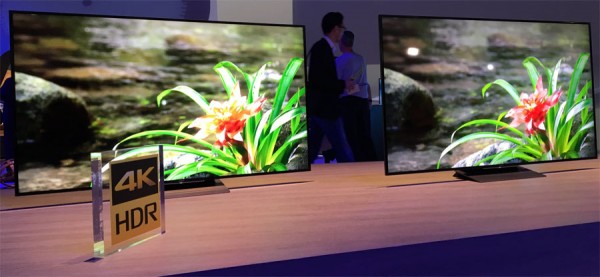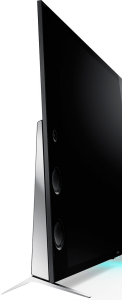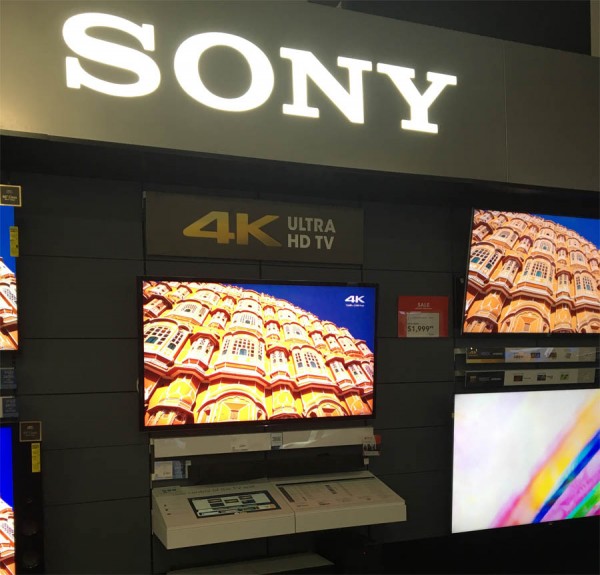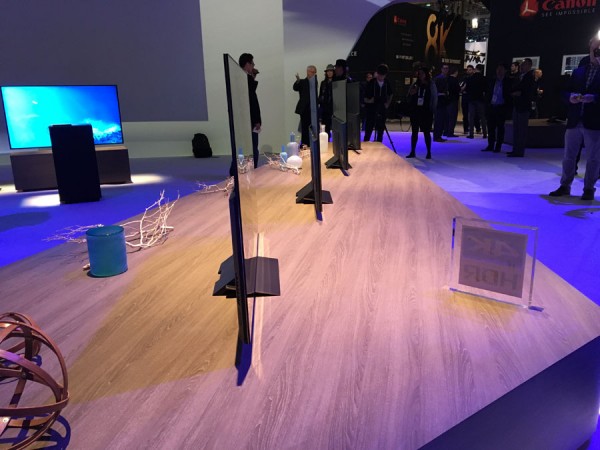
Besides looking aesthetically remarkable, especially when you look at the X930D as it spins around, you’ve likely noticed that the 4K HDR TV has shed some weight when compared against the 2015 X930C. That’s because, unlike Sony’s 2015 lineup of 4K TVs, which included the ultra-slim X900C and the flagship X930C with its built-in Magnetic Fluid Speakers, the 2016 lineup is just the X930D.
 Instead of creating two different high-end televisions that cater to different consumers, Sony has combined the two lineups, offering us one of their best looking televisions ever with deep blacks and bright whites while also playing into what consumers feel they want: even slimmer televisions. As someone who was a huge fan of the X930C, I truly appreciated the Magnetic Fluid Speakers which made setup far less complicated, that is to say that in our condo, we could have a TV that not only looked stellar, but one that provided audio that rivaled many surround sound systems without the hassle of dealing with all the wires.
Instead of creating two different high-end televisions that cater to different consumers, Sony has combined the two lineups, offering us one of their best looking televisions ever with deep blacks and bright whites while also playing into what consumers feel they want: even slimmer televisions. As someone who was a huge fan of the X930C, I truly appreciated the Magnetic Fluid Speakers which made setup far less complicated, that is to say that in our condo, we could have a TV that not only looked stellar, but one that provided audio that rivaled many surround sound systems without the hassle of dealing with all the wires.
The reality however is that in that equation, I’m the outlier and that Sony’s flagship series is primary targeted at home theater enthusiasts and wealthy consumers who likely already had surround sound or would have purchased one along with their new TV.
This meant that the X930C was priced higher than its competitors and was even seen as less aesthetically attractive, due to its bulkier design. Making matters worse, a segment of the community also complained that due to the speakers on the side (which were not removable), the X930C was harder to mount as you had extra inches on each side (pictured right). This is especially important for TVs that are mounted inside cabinet like fixtures or bedroom walls with limited space.
Though perhaps now a little less unique, Sony dropping their Magnetic Fluid Speakers is likely the right thing to do. More after the jump.
Picture quality aside, the lack of speakers do make the X930D less distinguishable from the glut of other 4K TVs that exist but that might just be what Sony needs. The truth is that most consumers shop on price point and with a lack of Magnetic Fluid Speakers, the X930D will surely be cheaper than the X930C. While in a perfect situation, you could take the consumer aside and show off the speakers Sony had provided versus a comparable Samsung with traditional speakers (which is what the X930D now includes), the truth is that most places that carry these TVs offer a less-than-ideal shopping experience.

From Best Buy (pictured above) to Costco, there are endless walls and rows with TVs stacked next to each other with little to differentiate one unit from the other. Even worse is the generic demo material that doesn’t provide much substance and help convey why that TV is unique. It’s not as if Sony is allowed to run a demo with high-pumping audio on their X930C series to attract consumers.
Even when I had gone to a Magnolia which is suppose to be a high-end store with expert staff to show the X930C for my parents, I had to take my own demo material as the supposed ‘trained staff’ members had little knowledge about Sony products or what their Magnetic Fluid Speakers could provide.
What instead ends up happening in more retail stores is that Sony has to rely on the consumers interest being peaked by their TV and investigating it further – or that the sales associate points them to their TVs over the other models offered. Even then, it’s still up to the sales staff to demo the TVs properly. Those situations aside, we’re left with a shopping experience where consumers are faced with a lot of TVs on store shelves with picture qualities that are good enough, leading to price becoming king as far as they’re concerned.
Sure this doesn’t mean that the shopper who was considering a Vizio would now likely purchase the X930D from Sony. Instead Sony now has a better chance at attracting the consumer who was looking at a comparable Samsung as the two TVs share a similar design and price point.

In a highly saturated marketed where consumers often shop with price on the forefront of their decision making price, Sony is able to make their X930D TV more attractive by dropping the Magnetic Fluid Speakers that made its predecessor unique but in turn helps take away any design/size barriers consumers would have had with the TV while also lowering its price.
Discuss:
Are you sad to see Sony drop their Magnetic Fluid Speakers from their TV line or does the decision make sense?

You must be logged in to post a comment.